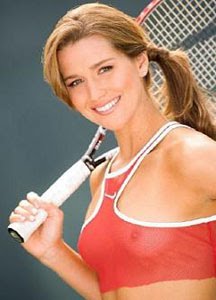 Jet-setting across the globe in pursuit of Grand Slams is a dream unique in itself. But trying to balance a marriage and excel on the WTA tour is a really tough challenge.
Jet-setting across the globe in pursuit of Grand Slams is a dream unique in itself. But trying to balance a marriage and excel on the WTA tour is a really tough challenge.In India, very few women have attempted breaking traditions by pursuing their sporting careers even after marriage, but their careers have never taken off. Sania Mirza might once again prove to be the path breaker.
On the WTA tour, many women have dared to scale new heights after marriage. Kim Clijsters has obviously taken it to the next level by winning Grand Slam titles even after having a baby. As a married woman, Liezel Huber rose to world No 1 in doubles and still continues to be a force on the tour. But it will be more challenging for Sania because she has cultural and traditional issues to deal with in pursuing her dream. Having said that, I know Sania handles pressure much better than anyone I have seen.
Sania’s marriage to Shoaib Malik can be the best thing for her tennis, in my opinion. Being a top cricketer himself, Shoaib is in sync with the level of focus and hard work that any game demands. During the Commonwealth Games and the Asian Games, I saw that Sania was more at peace and on solid ground, with the support she receives from everyone around her.
Her primary goal, back in November, was to get into the main draw of Grand Slams in singles. She has achieved her target by rising to 73 in the singles rankings, which will ensure her spot in French Open and Wimbledon. After watching her tame Tamarine Tanasugarn of Thailand, I hinted to her that her form reminded me of 2007 when she slammed her way into the final of the Stanford WTA event, beating top 20 players en route. Sania agreed and said that her confidence was also back on track.
In recent years, Indians have fared way better in doubles than in singles. Leander Paes’s best singles ranking was 73, but it’s his doubles game that propelled his ranking to No 1 in the world and gave him myriad Grand Slam titles. Mahesh Bhupathi and Rohan Bopanna, too have been successful in doubles. This could be attributed to the fact that Indians are more adept at volleys and the angles that doubles demands. Also one cannot overlook the fitness level that’s required for singles. I can assure you that the singles court dimensions suddenly seem wider and bigger when you are a doubles specialist!
Sania has won 14 doubles tour titles but her priority has always been singles. Her best doubles ranking was 18 back in 2007 when she won back to back titles before the US Open. She has two Grand Slam doubles titles to her credit, one in juniors and the other in 2009, when she won the Aus Open mixed doubles with Mahesh.
In the beginning of this year, Sania had limited success with
Czech partner Voracova at the Australian Open, but after Doha, Elena Vesnina and Sania seem to have found that niche. Indian Wells was a break-through event for them, where they claimed the title without dropping a set.
Sania has the capability to play on the deuce court or the ad court. That kind of adaptability is rare. Her colossal forehand is one of the best in the game and it’s her racquet-head speed that helps her pound the ball. I can vouch that it’s a tad scary to be staring down the barrel of her forehand when your partner serves a loopy second serve. The reason why this pair is so deadly is because Elena packs a serious punch off her backhand shot. Thus, this combination of high-powered forehand by Sania and Elena’s backhand make them a force to reckon with.
Sania’s volleys have never been a major strength, but that is mainly due lack of opportunities. While her technique is sound, her comfort zone has always been on the baseline. But with so many top level doubles wins under her belt, her confidence in coming to the net is bound to increase.
The other factor that sticks out in the statistics of her recent matches are the tie-breaks, where Sania and Elena have succeeded each time. In general, tie breaks involve some amount of luck too. But the consistency with which the tie breaks have gone Sania’s way are surely disproving that theory. I have seen Sania during these crunch moments in CWG and during the Asian games. Her ability to raise the level of her game a few notches at crucial times is what separates her from others. It’s the choices you make — to go for broke or play safe or play with controlled aggression. Sania chooses the last of the three options predominantly and comes out in flying colours.
While she might have expected more of herself in singles in the US hard court season, her doubles ventures have not been in vain. She has climbed to a commendable ranking of 29 within a three-month period. If Sania will choose to focus on both singles and doubles this year, she will need to select tournaments wisely in order to have enough recovery time between events. Looking at her current form, I won’t put a women’s doubles Grand Slam title past her in the next year.



















0 comments:
Post a Comment